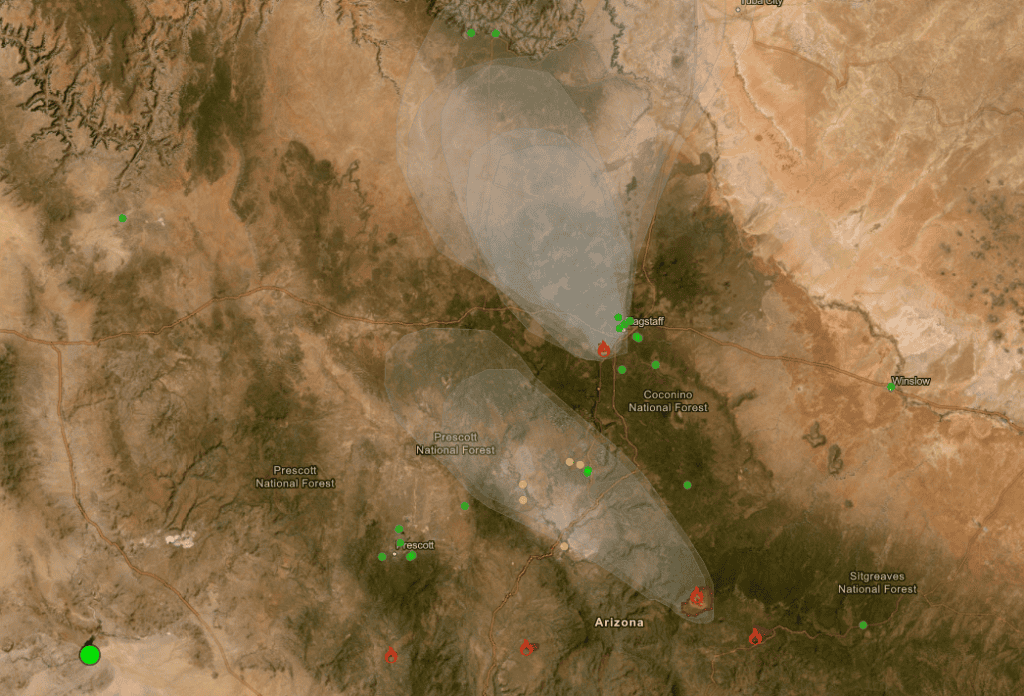The Verde Valley has seen a fair number of days with heavy smoke over the last few weeks as wildfires and control burns blaze in Northern Arizona.
Naturally-occurring wildfires over which we have little control begin with lightning strikes in isolated areas setting off brush and forest fires, such as the 15,074-acre West Fire burning north of Payson along State Route 87 on the way to Pine.

Wildland firefighters have managed to keep that blaze from crossing the highway and so far have kept the route open. The fire was caused by a lightning strike in late August and smoldered before winds kicked the blaze into a frenzy down the slope. For most of September, winds kept the smoke out of the Verde Valley, but at the end of the month, winds did send smoke into our valley, resulting in several days of hazy skies.
The nearby Preacher Fire is only 3,167 acres and was being managed by the same team as the West Fire, but is wholly contained.
Wildfires in the Western United States are a natural part of the ecosystem, and plant species from trees to brush have evolved coping mechanisms to survive wildfires or to take advantage of the altered landscape after a fire sweeps through an area, such as releasing more seeds or spores, or developing adaptive root systems that can store resources and quickly recover. The year after a wildfire, the “burn scar” area is often replete with new life as plants take advantage of the absence of a canopy and the dead plant material decaying into the soil.
Officials have more control over prescribed burns, however. Forest managers with the U.S. Forest Service, the Arizona Department of Environmental Quality and the Arizona Department of Forestry and Fire Management plan burns in selected areas of forest in place of the natural process that would normally thin out these areas.
These state and federal agencies typically schedule these burns during the cooler and wetter parts of the year, like the fall, when burning vegetation is less likely to become a conflagration raging out of control. These agencies also attempt to schedule these fires so the prevailing winds carry the smoke away from populated areas.
No one can really predict the weather and winds can shift dramatically without much warning over the course of a day due to a number of factors, bringing smoke into heavily-inhabited areas like the Verde Valley and Sedona.
Our journalist Joseph K. Giddens recently covered a meeting on wildfire smoke held at the Camp Verde Community Library with their forest managers and state officials to discuss the effects of smoke and how these agencies plan and carry out low-intensity burn operations, and we’ll have that story in next week’s editions.
Forest managers had planned a mechanical thinning operation known as the Four Forest Restoration Initiative, or 4FRI, to affect the Apache-Sitgreaves, Coconino, Kaibab and Tonto national forests, which are all connected forests stretching from the Grand Canyon to the New Mexico border along the Mogollon Rim.
The goal was to thin the forest by cutting trees for firewood and other wood products, but the contracted operators were woefully insufficient for the project and only successfully thinned a mere fraction of the lands targeted. So the Forest Service returned to burning operations, which remain the most efficient current method to thin out the forest, despite the destruction they wreak on the lands and vegetation, releasing massive amounts of CO2 and carbon into the atmosphere and undoing most of the “sustainability” operations of nearby communities aimed at reducing carbon emissions.
There are also economic concerns when burns send smoke into our skies, potentially turning off tourists who may want to visit — tourists on social media pages asking about visiting Sedona often question whether they should come when heavy smoke is reported by residents or in the news.
Until a more profitable and efficient mechanical thinning process presents itself, forest burning is likely to remain the main method for the foreseeable future. Smoky skies in the Verde Valley are still dependent on the weather and planning by fire officials.